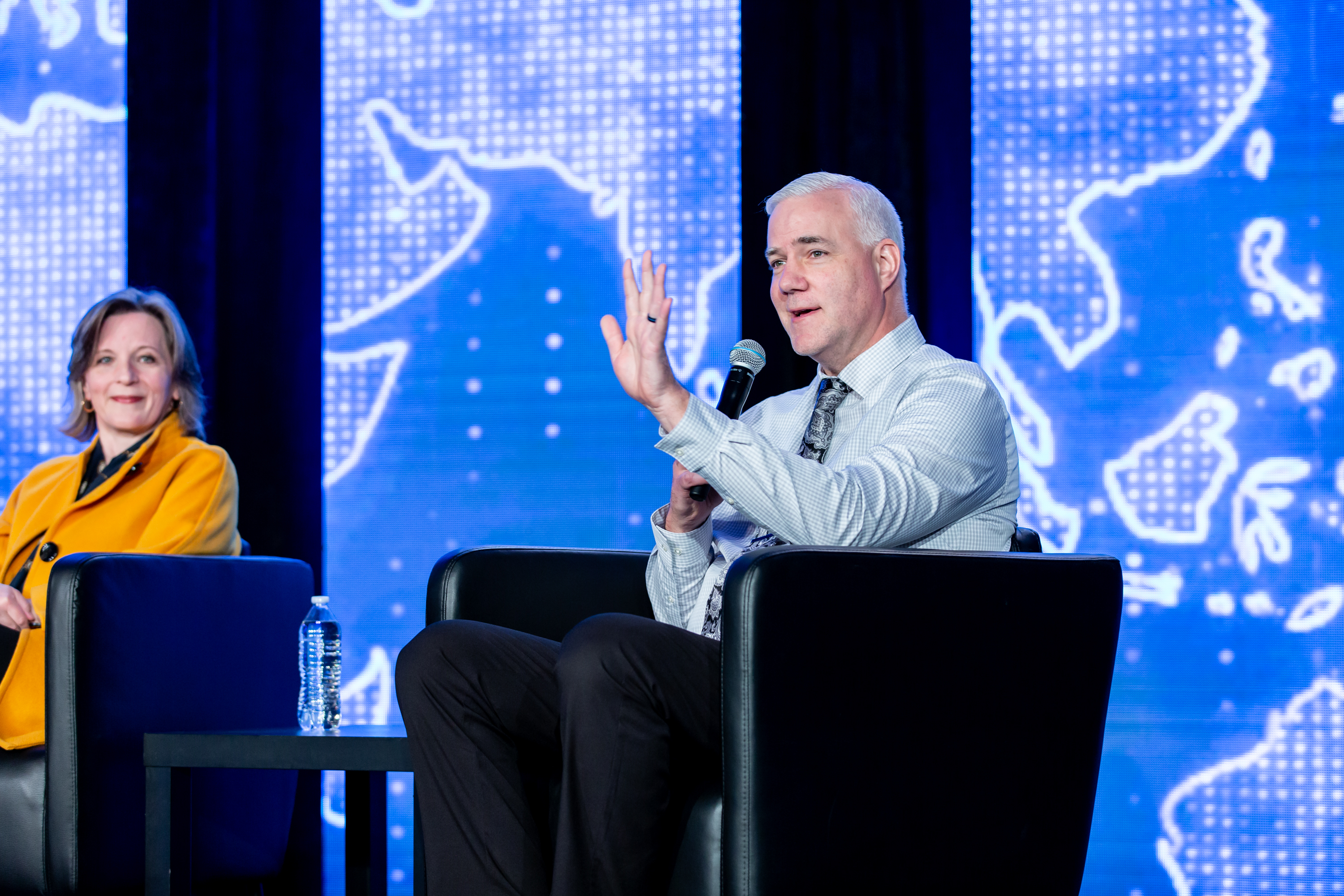-
Event recap: 2024 Midwest Economic Outlook Summit
-
Event recap: 2024 Midwest Economic Outlook Summit

Event recap: 2024 Midwest Economic Outlook Summit
February 22, The Chamber convened regional and national thought leaders for the Midwest Economic Outlook Summit at the Delta by Marriott in Fargo, North Dakota. This annual conversation serves as a pivotal platform for stakeholders to converge, share insights and dive into crucial economic discussions shaping the region's trajectory.
To kick off the morning, Joel Honeyman of Bobcat Company and Frank Matus of Thales discussed regional economics and the Midwest’s role in the global economy with moderator Dr. John Bitzan of the Challey Institute for Global Innovation and Growth. Touching on important topics such as technological innovation, workforce development and infrastructure investment, Honeyman and Matus provided an overview and specific examples of the strengths, advantages and opportunities of North Dakota and the Midwest.

“When we look at the economy as a whole, all of the initiatives that this state has going on – it’s something that is very attractive to a large global organization like Thales,” stated Frank Matus, “but it also allows us to bring technologies in from outside of the region to start to think innovatively about - How do we transform the economy? How do we diversify between just energy and agriculture? - And really start to look at advanced technologies as being that next wave of innovation that we can position our state and position our economy as being a world leader.”
This overview was followed by the keynote address, given by Curtis Dubay, Chief Economist at the U.S. Chamber of Commerce. Dubay's insightful analysis of domestic economics provided a comprehensive overview of the current economic landscape, addressing key factors influencing growth, workforce dynamics, inflation and geopolitical risks.
“We had COVID, then we had inflation, and then we had high interest rates,” remarked Dubay. “Usually when you have something like that, shocks to the economy, bubbles burst inside it. That didn’t happen in the last couple years – this tells me the underlying strength of the economy is pretty good. Once we can finally put inflation in the review mirror, once the economy has absorbed the impact of much higher interest rates, I think we are in store for a really long period of strong and robust growth.”

Dubay's remarks underscored the resilience of the U.S. economy despite prevailing challenges, highlighting the importance of workforce participation, consumer spending and productivity. He also discussed potential risks, including geopolitical tensions, 2024 election impacts, fiscal policy decisions and inflationary pressures, urging stakeholders to remain vigilant and adaptive in their strategies.
“The Fed wants a 2% inflation rate,” Dubay continued. “The Inflation rate is 3.1% as of January. So, we’re not quite there yet, but we are headed in the right direction.”
 Core Personal Consumption Expenditures Inflation (Measures prices of goods and services, does not include food and energy)
Core Personal Consumption Expenditures Inflation (Measures prices of goods and services, does not include food and energy)
See Dubay's entire slide deck here.
“The Fed looks at something called Core Inflation, it strips out food and energy. Food and energy are things we spend a lot of money on. Prices are up a lot higher than they were before inflation took off in March of 2021.” “What people want to see for the end of inflation is prices falling, but prices don’t fall,” mentioned Dubay. “Inflation ends when prices stop rising as much as they did the year before. So, everyone wants prices to go back to where they were, but that won’t happen, and there’s good reason for that. Deflation is as economically destructive as inflation. Think about it in your own businesses – your workers aren’t going to take lower wages, your suppliers aren’t going to take lower prices. If suddenly, you’re getting lower prices for your goods, that creates a problem.”
Following Dubay's keynote, panel discussions continued, featuring industry experts and leaders Brett Myer of Eide Bailly LLP, Libby Starling of the Federal Reserve Bank of Minneapolis and Matthew Leiseth of Hornbacher’s Foods to dive into the question of, “How far does your dollar go?” Chamber President and CEO, Shannon Full, moderated the conversation, driving discussion around the rising prices for consumers, investment strategies and mindsets, the business perspective on this challenging environment and what our specific region needs to be aware of as we continue to grow and compete on a national scale.

Matt Leiseth of Hornbacher’s commented, “I think the biggest reality is that everything impacts the price of groceries. There are so many things in the grocery industry that we rely on – and it’s everybody else - from trucking industries to production of crops. Everything that goes into the food that comes into the grocery store is impacted by inflation at every level that it comes in. All those little things add up to the bigger price that you’re seeing for all of those goods that come in.”
Throughout the day, participants engaged in thought-provoking discussions, addressing pressing concerns and exploring avenues for collaboration and growth. From housing affordability to investment strategies, each session provided valuable insights and actionable recommendations for businesses, individuals and policymakers alike. As the summit concluded, Shannon Full reiterated the importance of ongoing collaboration and dialogue to drive regional prosperity. The Midwest Economic Outlook Summit serves as a testament to the Midwest's resilience and ingenuity, reaffirming its pivotal role in the national and global economy.Tell a Friend
-
A catalyst for growth and prosperity.

